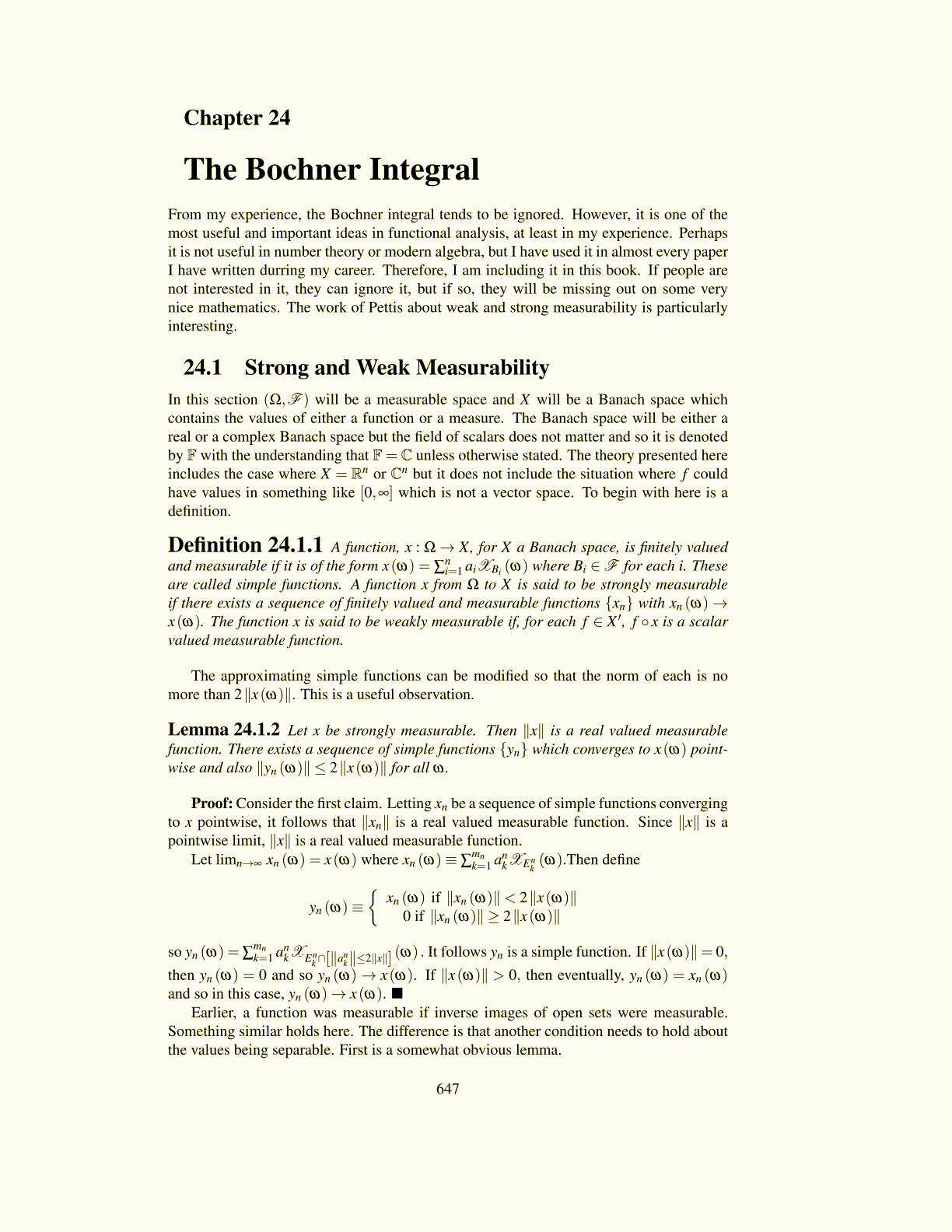
Chapter 24
The Bochner IntegralFrom my experience, the Bochner integral tends to be ignored. However, it is one of themost useful and important ideas in functional analysis, at least in my experience. Perhapsit is not useful in number theory or modern algebra, but I have used it in almost every paperI have written durring my career. Therefore, I am including it in this book. If people arenot interested in it, they can ignore it, but if so, they will be missing out on some verynice mathematics. The work of Pettis about weak and strong measurability is particularlyinteresting.
24.1 Strong and Weak MeasurabilityIn this section (Ω,F ) will be a measurable space and X will be a Banach space whichcontains the values of either a function or a measure. The Banach space will be either areal or a complex Banach space but the field of scalars does not matter and so it is denotedby F with the understanding that F= C unless otherwise stated. The theory presented hereincludes the case where X = Rn or Cn but it does not include the situation where f couldhave values in something like [0,∞] which is not a vector space. To begin with here is adefinition.
Definition 24.1.1 A function, x : Ω→ X, for X a Banach space, is finitely valuedand measurable if it is of the form x(ω) = ∑
ni=1 aiXBi (ω) where Bi ∈F for each i. These
are called simple functions. A function x from Ω to X is said to be strongly measurableif there exists a sequence of finitely valued and measurable functions {xn} with xn (ω)→x(ω). The function x is said to be weakly measurable if, for each f ∈ X ′, f ◦ x is a scalarvalued measurable function.
The approximating simple functions can be modified so that the norm of each is nomore than 2∥x(ω)∥. This is a useful observation.
Lemma 24.1.2 Let x be strongly measurable. Then ∥x∥ is a real valued measurablefunction. There exists a sequence of simple functions {yn} which converges to x(ω) point-wise and also ∥yn (ω)∥ ≤ 2∥x(ω)∥ for all ω .
Proof: Consider the first claim. Letting xn be a sequence of simple functions convergingto x pointwise, it follows that ∥xn∥ is a real valued measurable function. Since ∥x∥ is apointwise limit, ∥x∥ is a real valued measurable function.
Let limn→∞ xn (ω) = x(ω) where xn (ω)≡ ∑mnk=1 an
kXEnk(ω).Then define
yn (ω)≡{
xn (ω) if ∥xn (ω)∥< 2∥x(ω)∥0 if ∥xn (ω)∥ ≥ 2∥x(ω)∥
so yn (ω) = ∑mnk=1 an
kXEnk∩[∥an
k∥≤2∥x∥] (ω) . It follows yn is a simple function. If ∥x(ω)∥= 0,then yn (ω) = 0 and so yn (ω)→ x(ω). If ∥x(ω)∥ > 0, then eventually, yn (ω) = xn (ω)and so in this case, yn (ω)→ x(ω). ■
Earlier, a function was measurable if inverse images of open sets were measurable.Something similar holds here. The difference is that another condition needs to hold aboutthe values being separable. First is a somewhat obvious lemma.
647